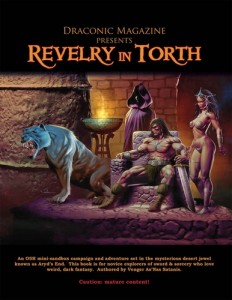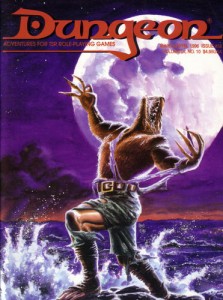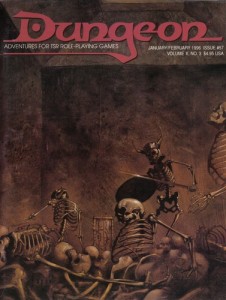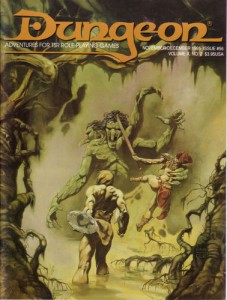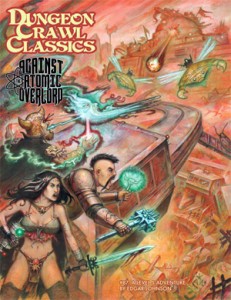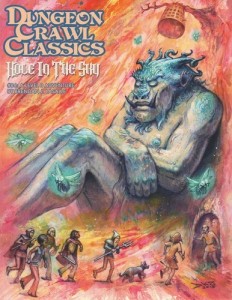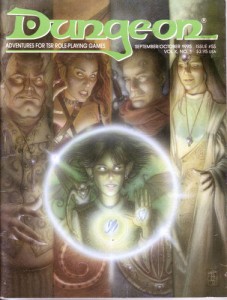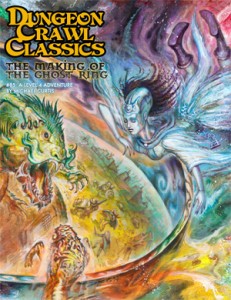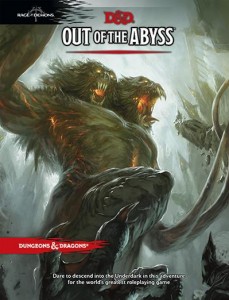
by Christopher Perkins, Adam Lee, Richard Whitters
WOTC
5E
Level 1
The Underdark is a subterranean wonderland, a vast and twisted labyrinth where fear reigns. It is the home of horrific monsters that have never seen the light of day. It is here that the dark elf Gromph Baenre, Archmage of Menzoberranzan, casts a foul spell meant to ignite a magical energy that suffuses the Underdark and tears open portals to the demonic Abyss. What steps through surprises even him, and from that moment on, the insanity that pervades the Underdark escalates and threatens to shake the Forgotten Realms to its foundations. Stop the madness before it consumes you!
This is a 250 page two-part adventure in the underdark that is, ostensibly, centered around demonlords. Some jackass drow cast a spell and now the demonlords have appeared in the underdark … but no one really knows that yet. The party starts off as prisoners, escapes, and makes their way out of the underdark, all in part one. In part two the party goes back into mess up the demonlords. It ends with a Royal Rumble, with each of the demonlords duking it out in a mass giant demonlord melee … that the party can determine the location of.
WOTC has given a couple of interviews in which they compare the underdark in this adventure to Alice in Wonderland. That is marketing nonsense; there is none/very little of that in this product. It is a serviceable adventure that will takes mountains of time to prep to play. It does a much better job than Hoard/Princes in presenting an adventuring environment, and even shines at times in some of the things it puts forward, especially with NPC’s and factions. It is quite weak in two ways: organization and what I’m calling, today, evocative specificity. In spite of this is manages to do an ok job presenting a sandboxy like environment with a plot. It’s light on railroads and heavy on needed DM prep … but maybe there is a way around that. As with all modern WOTC products, no one who has ever run a game at the table seems to have been involved in this product.
Let’s get the negative out of the way first and we’ll start with the organization of the product. There are roughly thirteen underdark locations descriptions, each in a separate chapter. There are also three of so “events” that get a separate chapter. Finally there are two chapters, one for the first “escape” half and one for the second “invade” half, that describe moving through the underdark. What there is not is an introduction or overview of the adventure to help you figure out what the F is going on. I’m a HUGE fan of plot coming out during play. Deep Carbon Observatory did this wonderfully. It was also much shorter and had no plot embedded in it. For a 250 page adventure with a plot there needs to be an overview that tells you how things work together.
The second part of the organizational problem lies with the chapters themselves, and more specifically with the locale chapters, which make up the majority of the book. They are laid out terribly. Each of these chapters is trying to do two things: describe the location and describe what happens at the location … to the party. This is the principal mechanism in which this sandbox has plot. You get to choose where you go, and what you do there, but there are events and motivations there as well, all related to the plot. The locale descriptions revolve around places, personalities, and factions … and it’s generally mixed in the plot portion. What you end up with a disconnected eventi-sh based description of the location. If the party doesn’t follow the script you’re left hunting the wumpus. Separating the two types of data would have been a much wiser decision, and allowed for better organization … which means better support for the DM. This is combined with ABSOLUTELY TERRIBLE layout templates that WOTC is using for these. The headings, colors, size, break-outs, etc all run together. It is terrible from a “easy on the eyes/picking out what I need to” standpoint. I’m pretty sure Princes and Hoard used the same layout.
The end result of this is that the chapters are hard to read and understand. This is not an adventure you are going to be able to pick up, read through, and run at the table. There will be a lot of rereading, photocopying, note taking, reference sheet preparing, and so on. Combined with the sandbox nature, that MAY mean you need to do that for several locations at the same time in order to be able to deal with the party’s free will. Maybe. The one saving grace here is the “Travel in the underdark” chapters. The chapter locations are relatively far apart. Two to three weeks of travel to get between locations is not uncommon. This COULD mean that you could roll some random encounters in the Travelling chapter, etc, and that can serve as a breakpoint for the DM, giving them enough time to run content until the end of the evening and, presumably, a week off to prep the next location chapter. That’s not a valid excuse for the crap organization job of the chapters, but it is a decent workaround.
The second issue is a general lack of detail, or, perhaps, misplaced detail. The drow guards sleep on pallets. Gee, that’s exciting. Wouldn’t it be much cooler if they slept in spiderweb hammocks, or maybe cocoon pods? That would reinforce the Alice in Wonderland nature that WOTC claims to be present in the product. There are multiple examples of this all over the book. Choices are made to describe something in length and detail which is completely unjustified. Meanwhile, other things are left a little too open-ended for my tastes. For example, there’s an EXCELLENT wandering encounter with The Society of Brilliance. There are some “monsters”, each of which has an 18 int and is fluent in multiple languages. They are dedicated to solving the problems of the underdark. That’s about it. That’s a GREAT encounter, but with just a little more it would have been even better. Instead of paragraph after paragraph of detail that is meaningless, a sentence on the NPC’s personality and maybe the problem they are specializing in? That would have really brought these folks to life. There’s this fine line in providing inspiration to the DM. It’s easy to provide too little and, perhaps, claim it’s left to the DM. Frequently when something is TOO open-ended the mind can’t focus. By constraining things just a little the mind can then explode onward. Not a paragraph. Not “Doing the DMs job for them.” Not a bunch of read-aloud. Just a sentence more to narrow things down a bit. This adventure is much better than Hoard/Rise/Princes in this respect, but still pales in comparison to a well written adventure. Another nice example of this is the madness that is infecting the underdark as the demonlords influence grows. There was a great opportunity here to provide some bizarre examples in each locations of freaky stuff going on. Instead the madness manifests as “psychotic rampage” … over and over again. No OCD scenes. No random mandelbrots in blood, while blind. Nope, just Monster Screaming Demonlord Battlecry and Attacking. Seriously, just about every time they yell “For the faceless one!” and attack, or something similar. They didn’t even try and make it interesting. L>A>M>E The magic items are almost always just as lame. No Alice/demontainted stuff here. Generic book treasure. Yawn.
Obvious railroads are few, but jarring when you run into them. The locations are, otherwise a little formulaic. There’s this “random” cave in of the tunnel which blocks off your access, front and rear, but opens a side passage to a temple next door to the tunnel. Uh huh. Nice one there. [Aside: the temple is in the process of flooding. It could have been just a bit more obvious that you NEED to make it flood to get out.] There’s a second one also, AN EVENT, that clearly represents someone in a meeting saying “We really need a big finish for the first part of this adventure. What can you give me?” There’s this “the drow are chasing us” mechanic going on through the first half of the adventure. Choices the party makes will cause the drow to get closer or fall further behind. It’s GREAT … if only partially implemented. The location chapters have details on actions to cause the drow to advance/get lost, but they don’t have much in the way of how that manifests. As a result the party doesn’t really know they are being chased until the drow catch them. A small table at each location for how the various chase levels manifest would have been great. That’s that lack of detail thing again. Anyway, I digress. As the party are leaving he underdark they are attacked by the following drow who have caught up to them! That is a TERRIBLE thing to do. None of the parties choices have been meaningful. They’ve all been taken away in an instant because some jackass wanted a big combat scene as the party exit the underdark. That’s stupid and insulting. It stinks of the Hoard/Rise style instead of a more open-ended style from Phandelver and most of this adventure.
Things DO get a bit formulaic as well. Show up at a location. They try to capture you as slaves/arrest you/offer you a job. One factions, the leaders, want to suppress another faction …. invariably the one touched by the demonlords madness. It seriously happens every time in the first half. Capture you, offer you freedom if you kill the other faction. There ARE factions, sometimes more than two, and that’s GREAT. It offers wonderful opportunities. The lame captured/arrested/hired mission style of play IS one way to add plot to a sandbox … but it’s far too formulaic in this. The worse example is the dwarf city in which EVERYONE is trying to capture you as slaves or arrest you for any reason … so you can get offered your freedom in you go on a mission.
That’s a lot of negative, and I do tend to focus on the negative. On the positive side it IS a more open and less linear style of adventure and that’s very refreshing coming from WOTC. The presence of the factions EVERYWHERE is a great thing. There are memorable NPC’s, quite a few of which are willing to join your party. How about an intelligent gelatinous cube as a hireling? The first chapter, the prison break, starts you off in this regard with a HOST of fellow prisoners with different personalities, goals, and are quite memorable. [Too much of a good thing? The DM could get saddled with too many extras to run. Anything smelling remotely like “DM pet NPC” sets off a hair trigger for me.] The fungus level is a nice little place that is the closest to a “Bizarre/Alice” theme. The end of the adventure has each party member taking control of a demonlord for a titanic battle royale among the various demonlords. That alone is a nice end cap to a campaign. It DOES manage to marry plot to sandbox in at least a halfway decent manner that is NOT completely full of railroads. It does stretch its legs sometimes and get VERY good, such as with portions of the Society of Brilliance.
It’s worth noting as well that the adventure uses quite a few of “minor rules.” Madness, exhaustion, downtime activities … all are represented in the adventure. They’ve done a fairly good job integrating them in. Crossing an underground river? I bet someone wants to make a raft! Downtime activities. Similarly, the madness rules are used to help represent the incursion of chaos from the abyss and the impact it has on those nearby. These minor rules are presented well and integrated well into the adventure. They don’t feel like a tack on. Nor do they feel onerous as, say, the rules from Wilderness Survival Guide did. Instead they are abstracted to a degree that they are not a burden to play and, in fact, support it. Nicely done.
I would suggest that it’s the best adventure from WOTC since Phandelver. It’s going to take MAJOR work to prep the chapters/locations, but in the end you’d have something halfway decent to run. I just wish WOTC didn’t you work so hard to have fun. 🙁
This is available on Amazon.
https://www.amazon.com/Out-Abyss-D-Accessory/dp/0786965819/ref=sr_1_1?&_encoding=UTF8&tag=tenfootpole-20&linkCode=ur2&linkId=119e03f84e594146a85750096bee3191&camp=1789&creative=9325
